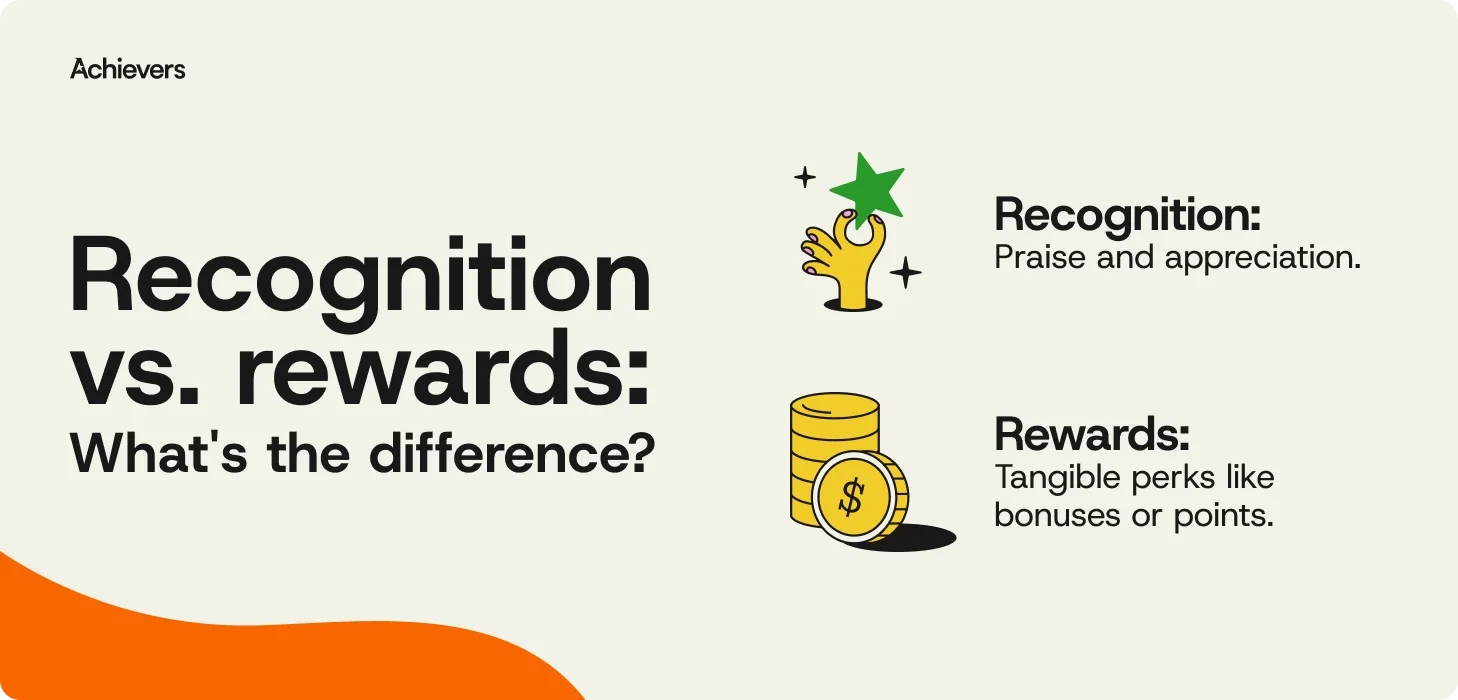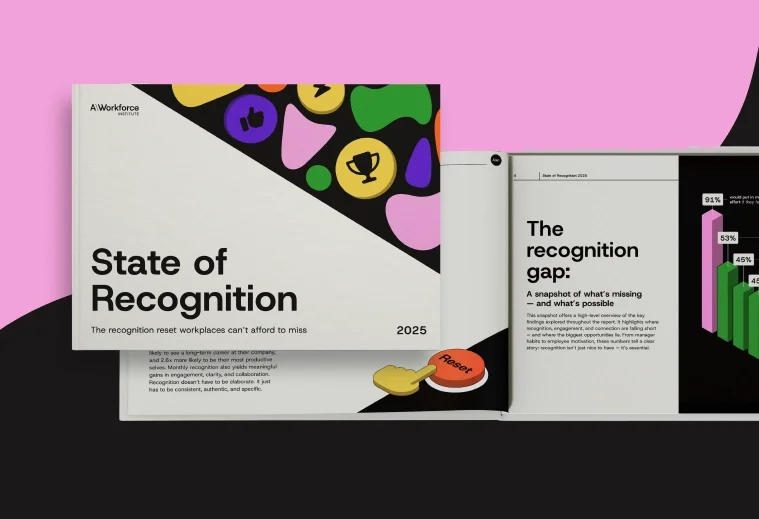Table of contents
Create a culture that means business™
Schedule a demo with an Achievers solution expert today.
A good rewards and recognition program can do wonders for engagement, motivation, and even your retention stats. (Yes, fewer exit interviews — you’re welcome.) But what separates a nice try from a program that actually moves the needle?
It comes down to how recognition is delivered. To really stick, it needs to be frequent, meaningful, and tied directly to the behaviors that matter most to your business. When recognition is weekly, in fact, employees are 2.6x more likely to be their most productive selves. Those insights from the State of Employee Recognition Report can’t be ignored.
In this guide, we’ll unpack what makes recognition truly effective, walk through reward strategies that work (and the ones that don’t), and share practical tips to help you build a workplace where appreciation isn’t an afterthought — it’s a habit. Let’s get into it!
What are employee rewards and recognition programs?
At its core, an employee rewards and recognition program is a structured way to say, “Hey, great job!” — and actually mean it. It’s how companies celebrate the wins, big and small, by recognizing employees for their efforts and offering meaningful rewards in return. These programs often live on shared platforms where recognitions are public (cue the warm fuzzies), and points can be redeemed for everything from gift cards to once-in-a-lifetime experiences.
The goal? Boost morale, encourage strong performance, and hold on to your top talent a little longer.
When done well, employee recognition doesn’t just make people feel good — it moves the needle on engagement, productivity, and retention. The good news? Building a recognition program that works isn’t rocket science. It just takes the right approach, a bit of planning, and a genuine commitment to appreciating your people.
Real-world recognition: Simple ways to show employees they matter
Recognition doesn’t have to be complicated. It just has to be real. Not every recognition moment has to come with confetti cannons (though we’re not against that). Here are some tried-and-true ways companies are recognizing and rewarding their people — and making it count:
- Work anniversaries that don’t feel like afterthoughts: A quick “Congrats on five years!” in the group chat is fine. A thoughtful message, personalized gift, or public recognition? Way better. Celebrating service milestones — whether it’s year one or year ten — shows employees that their commitment doesn’t go unnoticed.
- Appreciation events that go beyond the break room donuts: From virtual happy hours to team lunches and company-wide gatherings, appreciation events are a great way to step back and say thanks — without squeezing it into a slide at the end of a meeting. Bonus points if there’s cake.
- Achievement shout-outs that actually stick: Spotlighting wins — whether it’s crushing a project, hitting a stretch goal, or surviving quarter-end — reinforces the behaviors you want more of. Use team meetings, awards, or internal platforms to give credit where it’s due. And yes, humblebragging is encouraged.
- Employee spotlights that shine a little brighter: Weekly or monthly spotlights let you recognize individuals regularly without waiting for big milestones. A short feature in the company newsletter or a shout-out on Slack can go a long way in showing appreciation and inspiring others.
Recognition vs. rewards: What’s the difference?
Recognition and rewards often get lumped together like coffee and creamer — but they’re not quite the same thing. Recognition is the broader umbrella, covering everything from a heartfelt “thank you” note to a public acknowledgement of effort or results. Rewards, on the other hand, tend to focus on the tangible stuff — think bonuses, perks, and points you can actually spend. Let’s break it down:

Social recognition: praise that sticks (and doesn’t cost a dime)
This is your everyday appreciation — public shout-outs, thoughtful messages, high-fives (real or emoji). When it’s done regularly and genuinely, social recognition builds connection, boosts morale, and makes “thank you” a habit instead of a formality. The best programs make it easy for everyone — not just managers — to jump in and share the love. Peer-to-peer recognition? It’s not just nice; it’s powerful.
Monetary recognition: putting your money where your praise is
Bonuses, raises, travel experiences, gift cards — these are the kinds of rewards that come with a price tag and a big impact. But let’s be real: choosing the perfect reward for every employee is time-consuming, and no one wants another branded water bottle. That’s where points-based systems shine. They let employees pick what they want, when they want it — making recognition feel personal, not prescriptive.
In the end, the magic happens when social and monetary recognition work together. One says, “I see you.” The other says, “And I value you.” Combine both, and you’ve got a recipe for stronger engagement, better retention, and a workplace where people actually want to stick around.
Why bother with rewards and recognition?
A well-designed rewards and recognition program doesn’t just check the “nice to have” box — it has real, measurable impact. Beyond the warm fuzzies, it helps build a workforce that’s motivated, connected, and maybe even excited for Monday morning. (Hey, we said maybe.) Here’s what you can expect:
- Higher engagement, fewer eye rolls: When employees feel seen and appreciated, they show up with more energy and commitment. A points-based system keeps recognition flowing regularly — no need to wait for the annual review to say, “Great job!”
- Culture that actually sticks: Recognition is one of the simplest (and smartest) ways to reinforce your company’s values. When you highlight behaviors that align with your mission, those behaviors tend to multiply. Like office plants — only more productive.
- A stronger sense of belonging: Appreciation builds connection. When people know their work matters, they feel more included, more motivated, and more likely to stick around. It’s less “just a job” and more “I’m part of something.”
- Better teamwork, fewer awkward silences: When recognition is baked into daily life — not locked in a manager’s notebook — relationships thrive. Public praise, peer shout-outs, and team celebrations help create a culture where people lift each other up (and not just when there’s pizza).
Recognition by the numbers: proof it pays to say “thank you”
We all know recognition matters — but the data makes it crystal clear: a thoughtful, consistent rewards and recognition program isn’t just good for morale, it’s great for business. Here are a few eye-opening stats from Achievers Workforce Institute’s (AWI) 2024 State of Recognition Report to help prove it:
- Employees who are recognized at least once a month are 45% more engaged.
- Translation: a little “you crushed it” goes a long way.
- Regular manager recognition cuts turnover risk by 35%.
- A timely “well done” could save you a goodbye email down the line.
- Companies with peer recognition programs are 37% more likely to see business results.
- Turns out letting employees celebrate each other is a solid business strategy — who knew?
- Recognition programs focused on frequent, low-cost moments of appreciation are 26% more likely to deliver results.
- It’s not about big budgets — it’s about building habits.
- Social (non-monetary) recognition can make up 60–70% of total recognition and still move the needle.
- You don’t have to hand out gold bars to make employees feel valued.
- 96% of high-performing programs align recognition to company values.
- Want people to live your values? Recognize them for doing it.
- Milestone awards drive 50% higher retention than generic years-of-service awards.
- Celebrating meaningful moments beats the “Congrats on your annual survival” certificate every time.
Bottom line: when recognition is done right, it boosts engagement, strengthens culture, and keeps your best people around. And the best part? You don’t need a giant budget to make it work — just a little intention and a lot of follow-through.
How to build a recognition program that actually works
A solid employee rewards and recognition program is a strategic tool for boosting morale, shaping culture, and keeping your best people tuned in (instead of quietly updating their resumes).
The good news? Designing a great program doesn’t have to be complicated. With a clear structure, a little strategy, and a lot of heart, you can create something employees actually care about — and maybe even enjoy.
Here’s how to make it happen:
Recognize early, often, and without needing a 47-step approval process
Frequent recognition is key. When appreciation becomes part of the daily rhythm — not just reserved for birthdays or annual reviews — employees feel seen and supported. A simple, intuitive platform helps everyone join in, from the C-suite to the intern who just crushed their first project.
Be specific — “great job” doesn’t cut it anymore
Generic praise is easy to ignore. Effective recognition highlights what someone did and why it mattered. Think: “Thanks for jumping in to help the team meet the client deadline — your flexibility saved the day,” not “You’re awesome!” (Even if they are awesome).
Ask for feedback — and actually do something with it
Want to know what kind of recognition works? Ask your employees. Regular feedback (via surveys, pulse checks, or even a good old Slack message) helps you fine-tune your program. The secret sauce? Showing them you listened. That builds trust and engagement.
Supercharge your employee rewards and recognition program
When done right, a well-structured employee rewards and recognition program makes employees feel valued, fostering a culture of appreciation that directly impacts business success. Frequent, meaningful recognition that aligns with company values encourages the kind of positive behaviors that lead to better team dynamics and results.
A truly effective program strikes the right balance between social and monetary rewards. It’s about making recognition personal and impactful. The good news? You don’t need a manual for this. A modern, mobile-friendly platform like Achievers streamlines the process, supporting peer-to-peer recognition, manager-driven appreciation, and points-based rewards. Plus, with a wide range of rewards employees actually want, you can create a recognition experience that keeps everyone motivated — and happy to stay.




